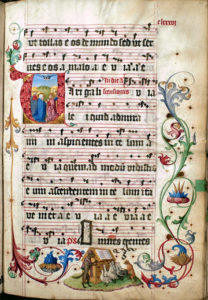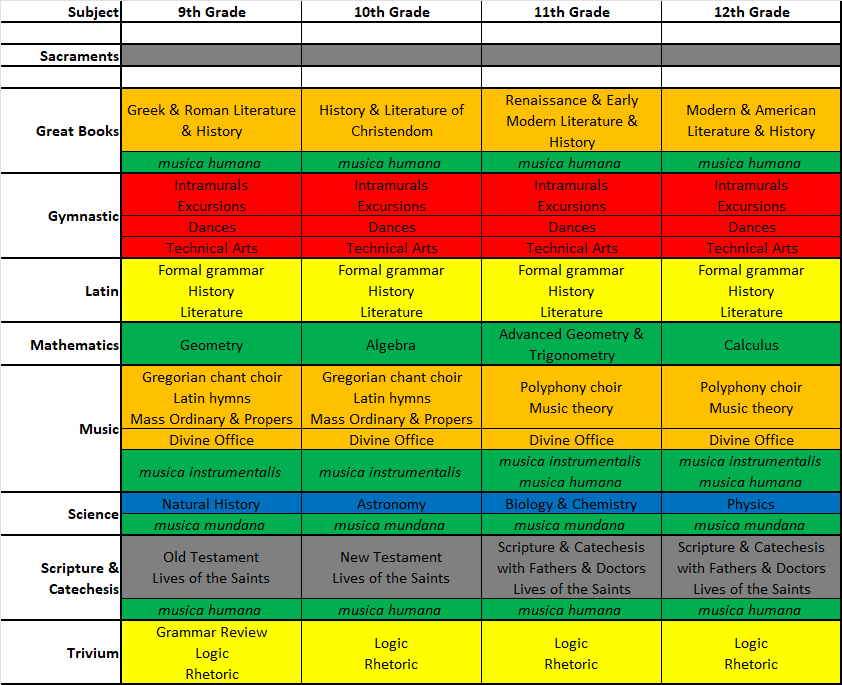The Order of Catholic Classical Education
As man is designed to be able to fulfill his purpose, Catholic classical education is designed to fulfill its purpose—to progressively cultivate virtue in the entire person. Each stage, each class, each step is directed in appropriately diverse ways, as required by human nature, towards knowing, loving, and serving God. Its foundation is the cultivation of virtue in the body and disposing students to love the good, which is the basis for moral virtue (A Pious and Musical Foundation). It continues with learning the tools needed to nourish intellectual virtue, namely, the Liberal Arts. Its completion is the cultivation of the intellectual virtues and the contemplation of God (Philosophy and Theology).
A Pious and Musical Foundation

Catholic classical education requires certain foundational preparations. These are piety and a musical education in a broad sense, meaning education in harmony and order of both body and soul. Piety rightly orders our intellect and will to common goods such as the family, society, and communion with God. In a musical education, gymnastic trains the body, while other formative activities dispose the soul towards what is good and beautiful.
Piety is the virtue by which one gives what is due to those who have made him who he is.[1] One’s existence, birth, and formation have been given by God and the Church, one’s parents and family, and civil society. By forming students in piety, they learn to look outside themselves and to see themselves as part of a greater whole. As Catholics, sons and daughters, and citizens, they have received something good and great, and it is their responsibility to receive it well and pass it on. In this way, piety prepares for all subsequent education. If fear of the Lord is the beginning of wisdom (Prov. 9:10), piety aims at completing that good beginning.[2]
Due to our fallen nature, our loves and emotions are not congruous with the good and beautiful reality that God has made.[3] These capacities must be cultivated and ordered rightly. Musical education in the broad sense meant here is not learning to sing or play instruments, but the cultivation of the capacity to love the good and be moved by the beautiful in reality. Thus, by stargazing, reading good books, and singing beautiful songs, musical education develops moral virtue by cultivating right loves and desires.
Gymnastic, or physical exercise and training, is part of a musical education in this general sense. This part of Catholic classical education is devoted to the development of virtue in the body, or physical virtue. It is good to have physical excellence of this sort. Also, physical virtue is the easiest type of virtue to cultivate and is needed for subsequent growth (such as controlling one’s body and holding one’s mind attentively on a task). It begins the development of virtue in the will and desires, or moral virtue—for example, perseverance and courage are constantly required on the field of play.
Students are in this way prepared to know intellectually the goodness of order and harmony that characterizes truths about the created order and God.[4] They have been prepared by acquiring a love of learning. They are ready for the liberal arts.
The Liberal Arts

Before things can be known in a philosophical way, one must develop the skills of thinking well and discerning the truth. These skills are the seven liberal arts, the necessary precursors to the intellectual virtues. The liberal arts are split into two groups: the Trivium—grammar, logic, and rhetoric—and the Quadrivium—arithmetic, geometry, astronomy, and music. The arts of the Trivium are about human language, while the arts of the Quadrivium concern the human measurement of quantity.
Grammar is the art concerned with language as a tool of meaning. The emphasis is not upon the form of thinking (as in logic) or speaking well for the sake of ends of action or persuasion (as in rhetoric), but upon language itself. Just as the violin-maker’s art aids the violinist’s art, so also the art of grammar aids the novelist, poet, logician, and rhetorician by developing the art of well-ordered speech.
Logic is the art of right reasoning, the art by which we can determine the truth of what is said or written. Its emphasis is upon the universal forms of thought as these are manifested in human language. As an art, it aims at the making of true definitions, statements, and sound arguments. This art thus trains the mind in knowing the truth.
Rhetoric is the art concerned with human language as a means of persuading one of the truth. It aims towards action as it involves inclining our will and emotions to act.
The Greeks were inspired to devise the arts of the Quadrivium because of the harmonies observed in the natural order of things. The medievals carried on this tradition, knowing as well that “thou hast ordered all things in measure, and number, and weight” (Wisdom 11:21). Arithmetic is the art of number, or discrete quantity, and geometry is the art of magnitude, or continuous quantity. These two aim at knowing quantity in itself, and the arts are thus preparatory for the study of mathematics. For the ancients, quantity as known in the things of nature, especially in things that move or change, was exemplified in astronomy and music. Astronomy is the art of observing the heavens, measuring and thereby knowing the geometric order in the cosmos. Music is the art of harmony, measuring and thereby knowing number in things.
Once a student possesses these seven liberal arts, he is able to discern the truth and is free to seek knowledge and wisdom. As St. Thomas states, “by these as if by certain ways the mind is prepared for the other philosophical disciplines.”[5] These arts so “excel all the rest in usefulness that anyone who had been thoroughly schooled in them might afterward come to a knowledge of the others by his own inquiry and effort rather than by listening to a teacher.”[6]
Philosophy and Theology
The liberal arts lead to the cultivation of the other intellectual virtues corresponding to the disciplines of human and divine knowledge—philosophy and theology. Philosophy is the pursuit of wisdom, the intellectual virtue that most perfects the human mind in the natural order. This is not philosophy in an academic sense, or an abstract consideration of hypothetical concept-games, but philosophy as it was for Plato or St. Thomas Aquinas, namely, the unified knowledge of creation in light of its Creator. The work of Catholic classical education is completed by theology. Theology, according to St. Thomas Aquinas, is sacra doctrina, holy teaching, which strives to know God through revelation (for example, in His nature as Trinity in unity). As sacred wisdom, it is both the highest intellectual virtue and the highest practical virtue.[7]
Philosophy and theology are best studied as an adult. Nonetheless, the education of younger students ought to prepare for philosophy and theology. Students ought to take first steps—wondering about the natural world, man, and the Creator—to begin the cultivation of intellectual virtue. Catholic classical education in high school cannot perfect their education at the highest level, but it can and ought to provide students with as complete a beginning as possible.
The study of philosophy in high school is focused on natural and practical philosophy. Natural philosophy is the knowledge of the natural world for its own sake. It includes what we think of as science today—biology, chemistry, physics, etc.—but contains much more by beginning with our immediate and common experience of things before asking the detailed questions of the modern disciplines. One ponders questions such as “What does it mean for something to be alive?” or “Why does a beaver want to chew down trees and make a dam?”[8] Practical philosophy includes the study of ethics or moral philosophy—how man should act—and political philosophy—how he should live in community to achieve the common good. While high school students likely lack the experience to fully understand moral and political philosophy, many of its topics and subjects can be included in the history and literature classes. There, concrete examples of political ideas in history or dramatic portrayals of virtuous and vicious characters are more readily seen and understood.
In high school, the student is prepared for the study of theology by intense catechesis. The deep reading of Sacred Scripture familiarizes the student with the word of God, encountering Him within the words and learning to recognize and understand Him. Studying the writings of the Fathers and Doctors of the Church forms the mind and heart to be able to see with the eyes of the Church. In these ways, the student encounters Christ and the Church and is thus well-prepared to seek God with all of his mind.
Curriculum Summary


Classes
Click on each of the links below for a summary of each class.
Footnotes
[1] See St. Thomas, ST, IIa-IIae, q. 101, a. 3.
[2] St. Thomas, ST, Ia-IIae, q. 68, a. 7; IIa-IIae, q. 19, a. 7.
[3] This is expressed well by C. S. Lewis in The Abolition of Man.
[4] Plato, Republic, Book III, 401e: “[H]e who has received this true education of the inner being will most shrewdly perceive omissions or faults in art and nature, and with a true taste, while he praises and rejoices over and receives into his soul the good, and becomes noble and good, he will justly blame and hate the bad, now in the days of his youth, even before he is able to know the reason why; and when reason comes he will recognize and salute the friend with whom his education has made him long familiar.”
[5] St. Thomas, Super Boetium de Trinitate, q. 5, a. 1, ad 3. See also Hugh of St. Victor, Didascalicon, Book III, ch. 3.
[6] Hugh of St. Victor, Didascalicon, Book III, ch. 3.
[7] See St. Thomas, ST, Ia, q. 1, a. 4.
[8] For a helpful literary analogy of how natural philosophy—and metaphysics even more so—is to be distinguished from our modern natural sciences, see The Voyage of the Dawn Treader by C. S. Lewis. While traveling, they meet a man, Ramandu, who says he is a “retired star.” Eustace replies, “In our world, . . . a star is a huge ball of flaming gas.” The star responds, “Even in your world, . . . that is not what a star is but only what it is made of.”
